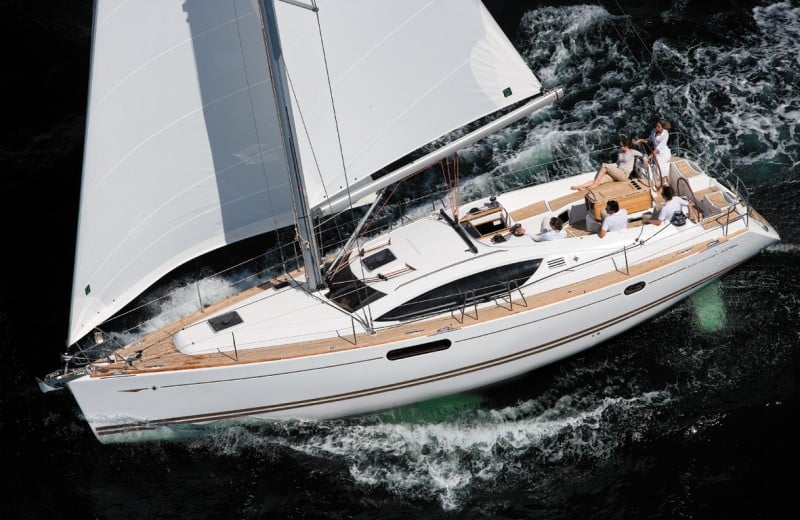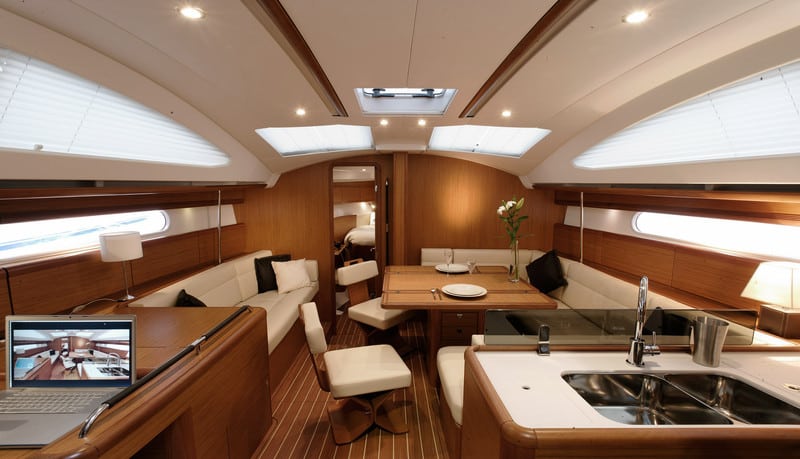
There’s no other way of saying it: I was confused. It was a gorgeous summer day off the picturesque French resort town of Les Sables d’Olonne, and I was in the very fortunate position of driving the spanking new Jeanneau Sun Odyssey 45 DS to weather in an ideal 12-knot southerly breeze. The sun was hot. The sea was flat. It was difficult to conjure a better afternoon for sailing. So why was I scratching my head?
It took a long moment to realize that I was suffering from the consequences of what might best be described as a spatial disconnect. Dockside, the 45-footer’s raised coachroof had left the impression of a yacht with vast interior volume, a sensation that was reinforced when I stepped below into a roomy saloon infused with natural light and providing exceptional vistas of the busy harbor scene. Once under way, however, and steering from the windward wheel on the twin helm stations, I was struck by the low, clean, unobstructed view forward, a vantage that allowed a clear look not only at the series of genoa telltales aloft but also of the twin anchor rollers right down at the bow.
Hence the simple, if confounding, question: How could this boat’s profile be high and expansive yet low and sleek-at the very same time?
The answer is instructive and evolutionary, for Jeanneau has been working on this knotty conundrum for the better part of this decade and through a growing series of highly successful deck-saloon sailboats, which started in 2002 with the Sun Odyssey 54 DS and now includes the 49 DS (2003), the 42 DS (2005), the 39 DS (2006), and this year’s 45 DS. With each successive offering, the builder has borrowed from the past while forging fresh territory, refining the concept in small yet progressive steps. And while Jeanneau hardly invented the deck-saloon idea-high-end builders like Oyster, Hylas, Swan, and others have employed the feature for many years-there’s no question that, of all the major production boatbuilders, the company has taken that ball and run with it like no one else.
Given what we now know-that sailors of all stripes (not just ones with very deep pockets) obviously appreciate the space, light, and interior that a deck-saloon layout provides-it’s important to realize that when the company introduced that initial 54 DS, it was rolling the dice in no small manner. At that time, there were few 50-foot-plus pure production boats available; Jeanneau’s largest yacht was a very traditional 52-footer. In other words, it decided to launch its biggest project to date with an untested style on a market that it wasn’t sure existed. This isn’t a theory of commerce preached at Harvard Business School.
What Jeanneau had going for it was a deep working relationship with Italian naval architect Vittorio Garroni, an innovative professor of design at the University of Genoa who’d been instrumental in the development of the company’s Prestige collection of motoryachts. Garroni made a persuasive argument that fellow sailors, like him, would be no less enamored of the sensory benefits derived from a raised floor, large windows, and increased “belowdecks” visibility than their brethren on powerboats. Garroni’s ultimate vision of the concept was elemental, and from a design standpoint, it worked backward from the distinctive cat’s-eye ports that he was already employing on the Prestige line.
At this stage, one point needs to be absolutely underscored: Had the boat sailed poorly, all the innovation in the world wouldn’t have saved the project. But with the 54 DS, Jeanneau commissioned Jacques Farroux, a performance-oriented designer, to create the hull, and the company has continued this practice with the subsequent models; Philippe Briand, another naval architect who first made his name with fast raceboats, took the baton from Farroux to refine the notion, and he was also responsible for the new 45 DS. As I learned first-hand off Les Sables, coursing upwind at an effortless 7 knots in the moderate breeze, it sails wonderfully.
The 54 DS was and is an unqualified success. Jeanneau America sold nine boats at the Miami Boat Show when it was introduced to the American market. (It had sold exactly two Sun Odyssey 52.2s, the model it replaced, in the several preceding years.) Today, the boat is still in production, with more than 300 built. The lesson learned? Given a price point hundreds of thousands of dollars less than what the semicustom builders were (and are) offering, the market for a substantial, affordable 54-footer was ready and waiting. So, too, were sailors looking for deck saloons in smaller sizes.

So what is it, exactly, about deck saloons that are so appealing? It’s perhaps no coincidence that in the five years since the launch of the 54 DS, and the appearance of other deck-saloons not only from Jeanneau but also from other major production yards in the U.S. and abroad, that cruising catamarans have also enjoyed unprecedented growth. After all, in terms of light and space, a deck-saloon sailboat is the closest thing in a monohull but often at a fraction of the cost of a similar-sized multihull. When it comes to powerboats, there are numerous similarities between a deck-saloon sailboat and a fly-bridge sportfisherman: Both employ interiors with wrap-around windows, curtains, and similar accoutrements.
However, as the marketing team at Jeanneau points out, deck saloons are really an evolution of center-cockpit designs, which in the plus column offer enormous aft staterooms and ample saloon windows, but in the minus may suffer from smallish cockpits, deep interiors (which can negate those big windows by providing views of the sky, as opposed to the horizon), and so-so sailing performance. In the evolving Jeanneau model, there are several givens: an aft cockpit, a raised cockpit floor to provide the headroom for an ample after stateroom (or twin double cabins), and an elevated saloon floor to provide that terrific eye-level visibility, which is what motivated designer Garroni in the first place.
Comparing the profile of the new 45 DS with the profile of that first 54 DS, the most startling difference is that the cat’s-eye windows in the smaller boat are, in fact, larger than the versions in the bigger model. Moreover, the overall lines are leaner and lower, particularly in the flow between the cabin roof and the cockpit coaming. The 45 has lost the “bubble” effect one sees on many DS boats (including the older Jeanneaus). To my eye, the look is quite contemporary and very pleasing.
There are a lot of other things to like about the 45 DS, including the long, workable cockpit; the modern, very stylish interior design, which is both handsome and functional; and the copious storage in bins beneath the floorboards, an added benefit of that raised saloon floor.
In short, the Jeanneau Sun Odyssey 45 DS is a fitting and commemorative birthday gift from the company to itself as it celebrates its 50th year of operation. And as deck saloons become even more widespread entities in the U.S. marketplace and abroad, for lots of good reasons, it’ll make a very nice present to more than a few lucky sailors, too.
Herb McCormick is a Cruising World editor at large.








